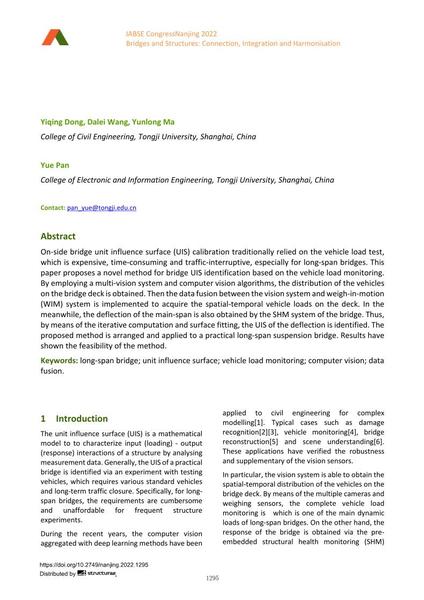Unit influence surface identification of long-span bridge based on spatial-temporal vehicle load monitoring

|
|
|||||||||||
Bibliografische Angaben
| Autor(en): |
Yiqing Dong
(College of Civil Engineering, Tongji University, Shanghai, China)
Dalei Wang (College of Civil Engineering, Tongji University, Shanghai, China) Yunlong Ma (College of Civil Engineering, Tongji University, Shanghai, China) Yue Pan (College of Electronic and Information Engineering, Tongji University, Shanghai, China) |
||||
|---|---|---|---|---|---|
| Medium: | Tagungsbeitrag | ||||
| Sprache(n): | Englisch | ||||
| Tagung: | IABSE Congress: Bridges and Structures: Connection, Integration and Harmonisation, Nanjing, People's Republic of China, 21-23 September 2022 | ||||
| Veröffentlicht in: | IABSE Congress Nanjing 2022 | ||||
|
|||||
| Seite(n): | 1295-1303 | ||||
| Anzahl der Seiten (im PDF): | 9 | ||||
| DOI: | 10.2749/nanjing.2022.1295 | ||||
| Abstrakt: |
On-side bridge unit influence surface (UIS) calibration traditionally relied on the vehicle load test, which is expensive, time-consuming and traffic-interruptive, especially for long-span bridges. This paper proposes a novel method for bridge UIS identification based on the vehicle load monitoring. By employing a multi-vision system and computer vision algorithms, the distribution of the vehicles on the bridge deck is obtained. Then the data fusion between the vision system and weigh-in-motion (WIM) system is implemented to acquire the spatial-temporal vehicle loads on the deck. In the meanwhile, the deflection of the main-span is also obtained by the SHM system of the bridge. Thus, by means of the iterative computation and surface fitting, the UIS of the deflection is identified. The proposed method is arranged and applied to a practical long-span suspension bridge. Results have shown the feasibility of the method. |
||||
| Copyright: | © 2022 International Association for Bridge and Structural Engineering (IABSE) | ||||
| Lizenz: | Die Urheberrechte (Copyright) für dieses Werk sind rechtlich geschützt. Es darf nicht ohne die Zustimmung des Autors/der Autorin oder Rechteinhabers/-in weiter benutzt werden. |
||||
